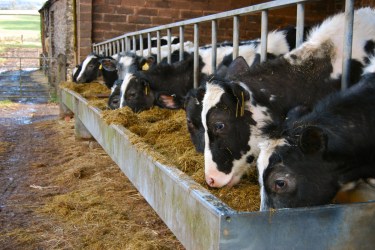By George Peart
With the right planning, infrastructure and protocols in place, using beef genetics on your dairy herd to generate a cash crop of beef on dairy can improve your annual profit margins. In part, this is due to the increased use of sexed genetics which has enabled farmers to produce female calves from their highest performing animals.
Like most things, however, it isn’t always a straightforward task to introduce beef genetics on farm and there are several things to consider before you embark on the journey.
First, you need to question if this approach will fit in with your overall business. The simplest way of breaking down your answer is to look at two factors: supply and demand.
Let’s take demand first
Arguably, the most important of the two is to understand if there is demand for beef on dairy calves within your local or regional market. It’s often predicted that beef on dairy is set to rise exceptionally over the coming years and could even rival suckler cow derived beef production in terms of annual product throughput.
This is unlikely to happen. Whilst UK milk production has remained roughly level since 2018 (just under 15,000 million litres), the national herd size has been gradually reducing and dropped by 1.5% to 2.65 million head in December 2020.
Fewer animals mean fewer pregnancies and given beef on dairy calves make up just 8% of the UK beef yield by animal number, the market for this product is unlikely to become saturated anytime soon.
What’s happening in your local area?
When looking around for market opportunities in your area, don’t be put off if every one of your neighbouring farms already sells beef on dairy calves. Yes, a high throughput at the local auction may lower prices, but several local beef on dairy enterprises might suggest that there are already mature supply chains catering to this product.
Selling directly off farm to weaning and finishing units could be an option too, especially if they can fill a trailer by collecting from numerous farms in one area. Perhaps there is an opportunity to split the collection costs with neighbours when selling a large batch together?
It never hurts to ask. There is great power in cooperating with other producers that you trust when looking to diversify, not just towards beef on dairy but for any new enterprise.
Let’s not forget that there is also enormous potential to lock supply, either of calves or finished animals, into retailer and food service supply chains for attractive premiums. As supermarket chains look to provide consumers with a more standardised product, the attractiveness of the consistency that some genetic lines can provide will increasingly become the norm.
Evaluating ‘high health’
It may seem obvious, but the quality of the beef on dairy calves that you produce is just as important as the numbers. It is, therefore, crucial to have a biosecurity plan in place. This starts by assessing your calf shed and buildings for airflow, and the ease of cleaning and calf management; the easier the building is to use the more likely strict biosecurity will be maintained.
Combining a well-planned environment with high-quality inputs in the form of colostrum, dairy-based milk powder, a tailor-made calf feed and ad-lib straw will also be critical to producing a high-quality calf.
You can’t forget animal husbandry either. The higher the quality, the better the product. Try to plan your calving dates for your herd so that the calves are moved from pen to pen as a batch instead of drip-feeding the pen one at a time. This will be key to reducing diseases and bacterial load.
To produce accurate costs, don’t forget to investigate the contract demands of finishing units and even the auction mart. What ‘high health’ means for one of your customers may be different to another; you need to evaluate if you fit the criteria and whether to factor in any vaccination or added biosecurity costs.
Maintaining herd size
Now you have looked at demand, both in terms of quantity and quality, it is time to delve into supply. In other words, how will you manage your dairy cattle in order to maintain herd size and genetic progression whilst producing this cash crop of calves?
The answer: a heifer replacement calculation and overall herd ranking.
Heifer replacement number = Herd Size X (Age at First Calving in Months/24) X Cull Rate X (1+Non-Completion Rate) = Annual number of Heifers Needed.
Based on this equation, a herd of 100 cattle who are calving their heifers at 24 months, have a cull rate of 25% and a heifer non-completion rate of 10%, will need 28 replacement heifers annually to maintain their herd size.
These heifers must come from the best genetics in your herd. What ‘best’ means is totally up to you and your business goals, but by setting your herd genetic priorities and using genomic or other assessments you can ‘breed the best, beef the rest’.
Adopting a “beef on dairy” mindset is about maximising the value of the calf crop. It relies on good fertility, good planning and the careful use of sexed genetics. The wins are two-fold; you get faster genetic progress with the dairy herd and higher profits through the sale of beef animals that meet market needs.







